One Day On The Water In SE Alaska
Wednesday, August 20th, 2008 at 4:27 pm by Ken
|
Technically, we were on the water for three days, but all the images you see in this blog post were taken on Sunday, August 10th. I was privileged to be invited to spend a week with pro photographers Jon Cornforth (www.cornforthimages.com)
We were there to photograph the humpback whales (Megaptera novaeangliae) that migrate up to the coast of southeast Alaska for summer feeding on krill and small schooling fish such as herring and mackerel. We spotted whales feeding near the small town of Tenakee Springs (above). This was the only town for many miles around, but the fish must have been there, because the whales stayed close to the town for a good portion of the day.
Our primary goal was to get shots of the whales’ inventive technique known as “bubble net feeding.” This is a form of co-operative feeding behavior that is almost unique to this species (see my earlier post from a February 2008 trip on how sailfish do something similar). The humpbacks dive beneath a school of fish and encircle them in a “net” of bubbles that the fish won’t swim through. The whales then swim up through the bubble net, surfacing with their mouths open and their throats engorged with fish, which they swallow in one gulp. A recent article in BBC Wildlife Magazine described bubble netting as “…one of the most extraordinary displays in the natural world…” and having now witnessed it I would certainly not disagree with that assessment. The above shots of this behavior are from a fairly typical vantage point–since these are marine mammals in U.S. waters, you must keep a respectful distance and use a long lens (I had an 80-400mm zoom).
These three shots were from a single encounter where the whales popped up suddenly, much closer to the boat. To say I was unprepared is an understatement. We usually tried to be on the bow when the whales surfaced. When this one happened, I was still inside the boat and had to just poke my camera through the portside window. Needless to say I was fortunate to get these shots, helped by a camera shutter speed of about 1/1000sec and image stabilization technology in the lens.
Some other humpback shots. We didn’t have good light, but the Alaska background was nice.
Since the Olympics had just started, I decided to add this shot from the "Synchronized Fin Wave & Bird Landing" event. The whales have their pectoral fins aligned pretty well, but those birds look like they need a bit more practice!
Oh, and there are bears in Alaska! Because Jon’s boat is a compact 22 feet, we were able to motor up a stream and do some land-based shots of this young grizzly bear (Ursus arctos) trying to catch salmon beneath a waterfall.
As I mentioned, we didn’t have much in the way of good light–those overcast skies in the photo above left were typical. As shown in the photo above right, we did get some shafts of sun for “golden light” during the long twilight (it didn’t get truly dark until around 10:00pm), but we weren’t able to get the uncooperative whales properly aligned with the setting sun. Hey, no complaints though! Considering the six days we’d planned to be out there photographing had been cut down to one, I was more than happy with the results! Best to all, |
||||||||||||||||||
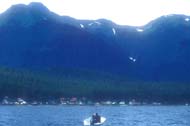


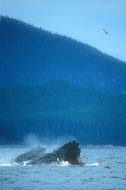

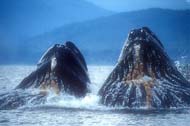

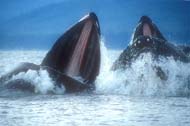

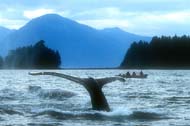


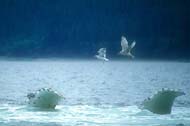




 Permalink
Permalink Filed under:
Filed under: 